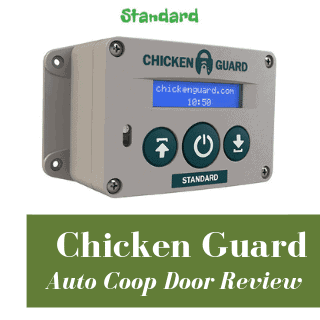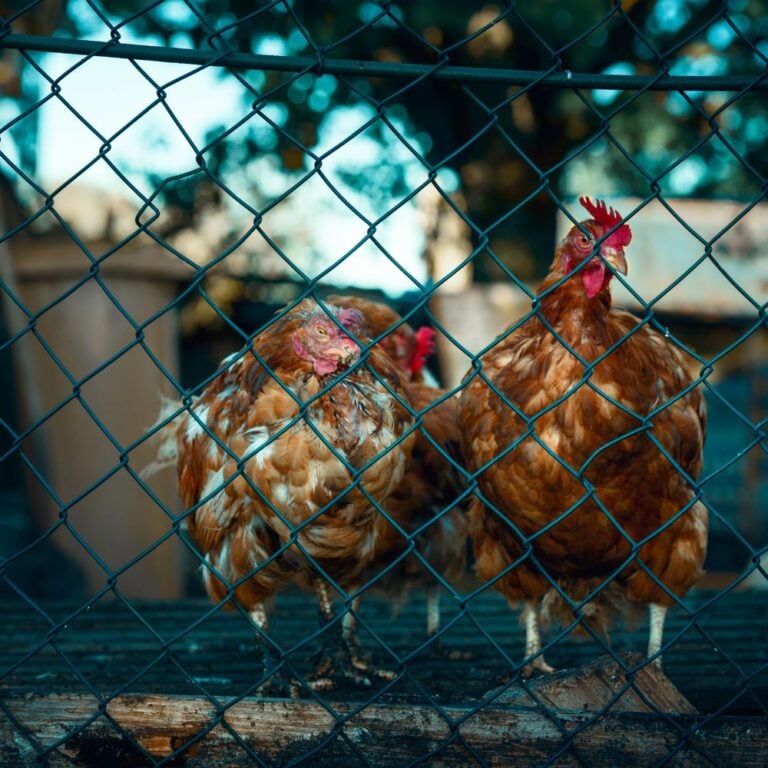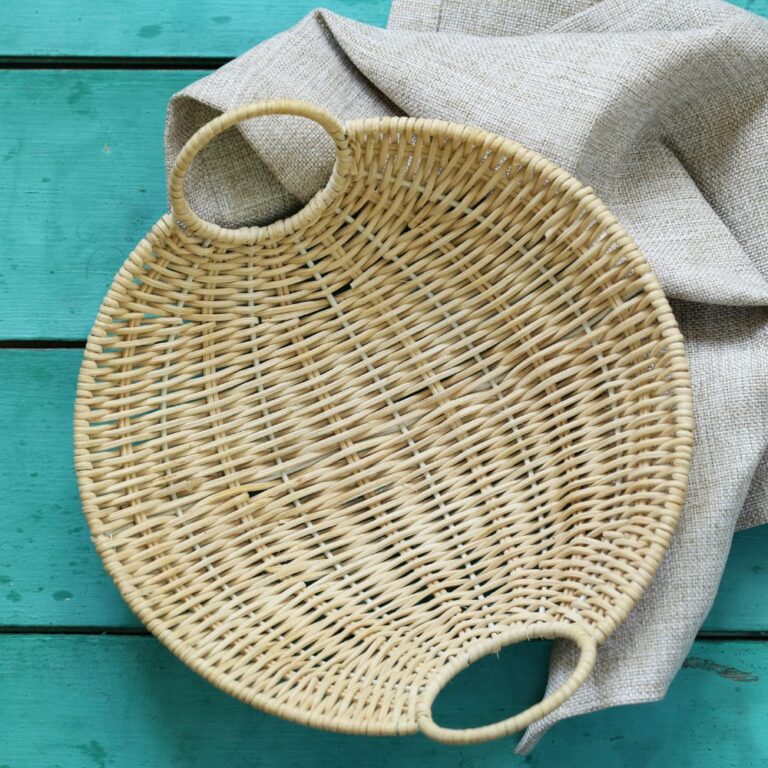There are all kinds of walk-in chicken coops, both complete and ready-to-buy, as well as DIY plans, but there are a lot of things you need to think about before getting (or building) a coop. Trust me when I say, you don’t want to be stuck and irritated with the end result. This should be your flock’s favorite place, and you should enjoy it too.
If you are new to chicken lovers paradise, you might be thinking something like “a coop is a coop, what’s the big deal?” Well, as a long-time chicken owner – I will tell you that you need to put some thought into it. You can learn from my advice, or you can learn the hard way. Read on to take the easy road. 😉
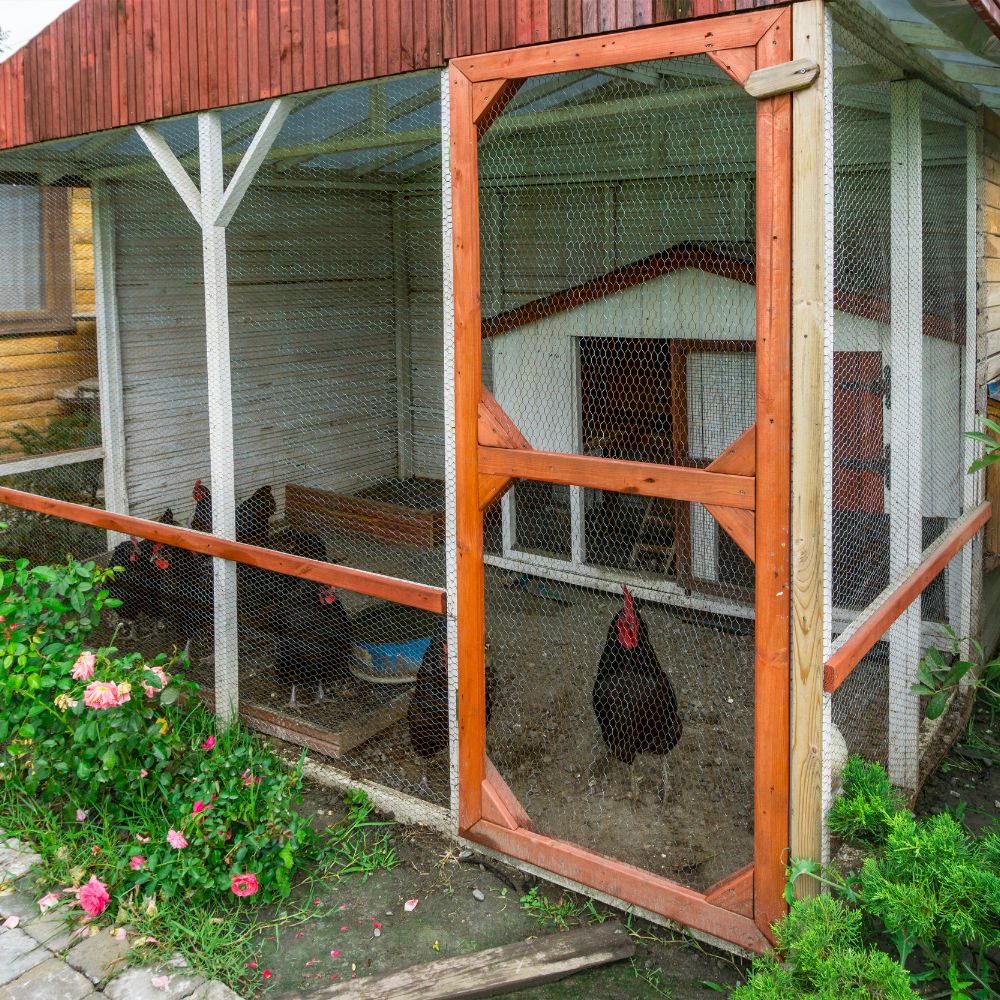
Table of Contents (Quickly Jump To Information)
Essentials for a Walk-In Chicken Coop
First up, we are going to get the essentials out of the way. Anything beyond this is just extra or preference, but the things I will point out here are necessary (in my experienced opinion).
Practical Coops
My father-in-law has a saying. I’m sure he didn’t coin the phrase, but he sure says it a lot. What is this saying? Here we go…”it was made to sell, not to use.” There are SO many products out there today that were made just that – to sell but not made to actually use.
Chicken coops, and chicken coop DIY plans, can definitely fit this clever little saying. There are many walk-in chicken coops out there that are just as cute as can be, or super fancy, or super cheap…that weren’t made with the users in mind (chickens and chicken owners alike).
Trust me when I say, you want a coop that is practical for daily use. As we go through the other essentials, keep this in mind the entire time. Never choose a coop just based on how cute or fancy or cheap it is.
Walk In or Duck In? That is the question!
We are talking about walk-in coops here. Walk-in chicken coops are amazing to use. There are a lot of walk-in coops out on the market that aren’t exactly walk-in coops. They are more like duck down-hunch over-squeeze in-coops. 😆 It’s all fun and games until you actually want to walk into your coop.
Since, I assume, you aren’t a hobbit – be sure you can walk in and stand up straight. You’ll thank me for this later.
Clean Dream
Let’s face it. Cleaning your chicken coop isn’t exactly the favorite thing in the world for chicken lovers to do. We want to watch our chickens peck about, we want to gather eggs daily, and we want to see our chickens running to us for treats (my chickens love these treats).
However, we have to clean the coop because our feathered friends are not going to do it themselves. This point goes hand-in-hand with the previous point about being able to actually walk into your coop without hunching, stooping, or crawling.
Your coop needs to be such that you can actually walk inside comfortably and use a little elbow grease…or shovel…or whatever you need to use to clean the coop out.
Any enclosures within that coop, such as the nesting box area or place the chickens get out of the weather to stay dry and warm, need to be reachable. Every corner needs to be accessible so you can clean it without sending your 3-year-old in to do the job. You want to be able to reach all the nooks and crannies.
Wire
Any wire on your coop needs to be such that small chicks can’t get out through the holes and that predators can’t get in. The kind of wire you need will depend on the kind of predators you contend with.
There are SO many kinds of wire out there. Everything from plastic “wire” (called netting) to galvanized wire to wire mesh. There are many sizes and weights, light-duty and heavy-duty, and the list goes on.
Whether you buying or building a coop you need to educate yourself before buying wire or choosing a coop. Everything you need to know is in these two articles we wrote: Chicken Wire For Coops: Buyers Guide and What Chicken Wire Is Best For a Coop?
Predator Proof
You won’t care how cute your coop is if predators can easily find their way in. Practical predator proofing is worth its weight in gold.
It’s important that the coop you build or buy, is strong and sturdy and doesn’t have areas that can be compromised easily. See the section on chicken wire because that is one of the biggest elements to keeping predators out. Everything from the size of the hole to the weight of the wire to how it’s installed and secured…all of these things make a big difference.
Some other things can make a difference in how predator safe your coop is. The weight of the coop’s frame itself might be a factor. Is it super lightweight? Some predators can wiggle their way under a light aluminum framed coop, for example.
You’ll need windows (or at least one window) in your coop for ventilation. Does the window have suitable chicken wire over it? Or can predators climb right in?
Learn all about how to build a predator-proof coop here. It’s also a good read even if you are planning on purchasing a coop – know before you go.
Ventilation
Chickens poop a lot. And chicken poop stinks and quickly becomes an ammonia-scented complex of moisture. This is pretty much unavoidable (unless you plan on thoroughly cleaning your coop a couple of times a week). Therefore, you need to have good ventilation.
Good ventilation helps keep your flock healthy, it also helps reduce mold and bacteria growth. Ammonia can be especially bad for respiratory systems (for both humans and chickens).
Another thing you can do to help keep your coop fresh and inviting is by using nesting herbs. They not only smell delightful, but they also serve a greater purpose as well. Check these nesting herbs out and read about the benefits here.
Space
How many chickens do you need to house or how many do you plan on housing in the future? This is important because your coop needs to be large enough to provide ample space for your chickens to thrive. Each chicken needs plenty of room to move about.
Whether or not you will be free-ranging your birds will alter how much space you need. Obviously, if you don’t free range, your chickens will be cooped up most of the day and would need more space in the coop and the run.
How much space does each bird need? Each bird needs about 10 square feet of space to live happily and healthy, especially if they are not free ranging. Read more about the number of chickens you should have in your space here.
Roosting
Chickens were made to roost. They need to roost. They want to roost. Chickens need roosting bars. It’s where they go to spend the night. If your coop doesn’t have roosting bars your chickens will try to roost elsewhere if they are free ranging.
If they aren’t free-ranging, they will be miserable and likely get sick. It’s also very hard for chickens to stay warm when huddling on the wet, poopy coop floor (especially if the floor of the coop is not insulated or doesn’t have much of a barrier).
Nesting Boxes
Hens need nesting boxes, or laying boxes, in order to lay their eggs with ease. Otherwise, they will lay their eggs all over the place if they are free ranging. If they aren’t free-ranging, they will lay their eggs on the floor or ground in the coop. The eggs will be soiled, broken, and your hens will be stressed.
Also, if you ever want your hens to brood their own chicks, they will need a place to lay and set on the eggs. It’s best to put nesting herbs in their boxes to encourage them to visit often!
Moveable or Stationary Walk-in Chicken Coops
There are all kinds of chicken coops, even when narrowing it down to walk-in chicken coops. There are coops that stay where you put them (made to be stationary) and there are coops that are meant to be moved regularly (often called chicken tractors).
As a side note, you might be a curious soul like myself and wonder why a moveable coop would be called a chicken tractor. At first, I thought it might be because you need a tractor (or something like it) to move the coop because it’s so heavy. That theory is weak because many of these are moveable by hand. The real reason they are called chicken tractors is that the chickens peck and scratch at the ground a bit like a plow…or tractor.
You need to decide if you want to move your coop around or not. If you don’t want to free range your flock, or can’t free range your flock, then a chicken tractor might be very beneficial. They allow your backyard buddies to clean up bugs and grass and get minerals and grit as well. Overall they will be healthier for it.
Chicken coops that are made to move are constructed differently. They usually have skids or wheels and they can’t be too heavy or you won’t be able to move them easily. You need to pay close attention to how these kinds of coops are built. Often times they are elevated a bit off the ground for easy movement, but that can open the way for certain predators to more easily dig their way into the coop.
Larger coops are usually such that you won’t be moving them. However, there are larger coops that are set up to literally be pulled by a tractor when they need to be moved.
Door Details
This probably goes without saying at this point, but the walk-in design needs to have a coop door that is an adequate size. Again, you don’t want to hunch and bend down to get into your coop. You need easy access.
You might have a moment where you think that’s not a huge deal as long as you can stand up once you are inside. However, for optimal cleaning, you don’t want to have to bend over every time you go in and out of the door with a shovel or tool or choice.
You will also want to be sure the door has a good sturdy latch to keep it shut and predator-proof. Some coops have a double latch entry system, some have sliding locks, and so on. Just be sure it’s safe and also easy to use. You don’t want to fight with the door lock every time you go in and out.
I often have something in my hands, like food scraps or treats, and need the door latch to be easy to open with just one of my hands.
In addition to that, the coop also needs a dedicated chicken door. This is much like a doggie door so your chickens can go in and out freely. If you free range they can go work all day but come back and forth to get a drink or lay an egg. If you keep them cooped up, then they will need constant access to their outdoor run as well.
Chicken Run or Chicken Enclosure
If you are not able or don’t want to, free-range your chickens then they will need a run of some kind. If you are using a stationary coop, then you need to attach an enclosed run for them to get sunshine, peck at bugs, and run around for exercise.
Now if you have a chicken tractor, the chickens will have access to fresh ground, grass, and bugs as long as you move the coop often enough. There is no magic number as to when to move the coop, it will depend on the size of your coop, the number of chickens you have in the coop, the time of year, and the condition of your land.
Weather Proof Walk-in Chicken Coops
You need to take into consideration what region you live in. Some regions have cold climates or even frigid climates, others have very hot climates, and yet others are in between.
If you live in a cold climate, for example, then you are going to need a coop that has a really warm place for your chickens to get out of the weather when needed. You likely wouldn’t want to choose a coop with an aluminum frame and a tarp as the cover. You might consider a coop that has an inner hutch they can get into.
If you live in a hot climate, you will need more ventilation and airflow. Some coops might need vents. In hot climates, you would not have to be as concerned about freezing temps even in the winter.
Most of us live where we have a little of both, cold and hot. Regardless of the weather you have to contend with you simply need to keep this in mind when you are deciding what coop to use. It’s better to think of this beforehand instead of after the fact.
Both coops that are already made and coop plans have all kinds of configuration options to choose from.
Summary
Considering a walk-in chicken coop for your backyard flock is exciting. Make it fun and don’t stress. Keep all these tips in mind so you can love your coop, not hate it.
Do your research and don’t compromise, you’ll be happier long term if you get something that works well and is easy to take care of.
Walk-in Chicken Coop Examples
Below are a few walk-in chicken coops as examples that will give you an idea of some of the designs that are available. You can also find ideas and plans with a quick internet search.
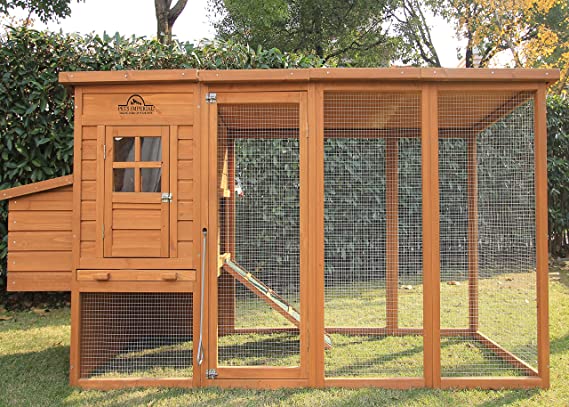
Pets Imperial® Arlington Chicken Coop
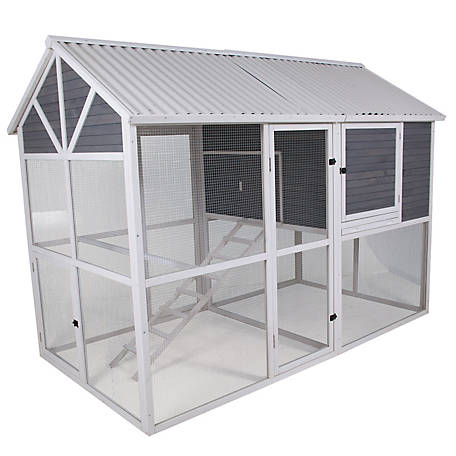
Garden Walk-In Chicken Coop
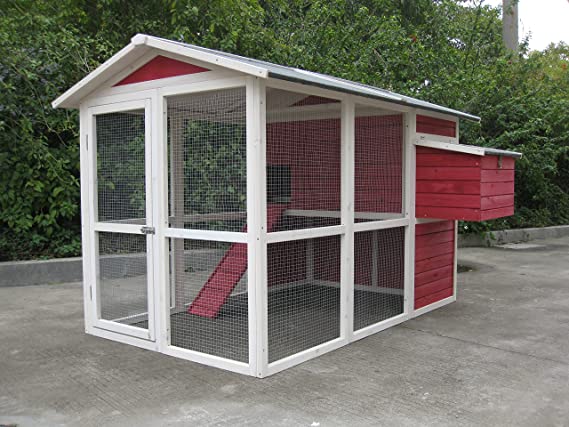
Coops & Feathers Large Chicken Coop
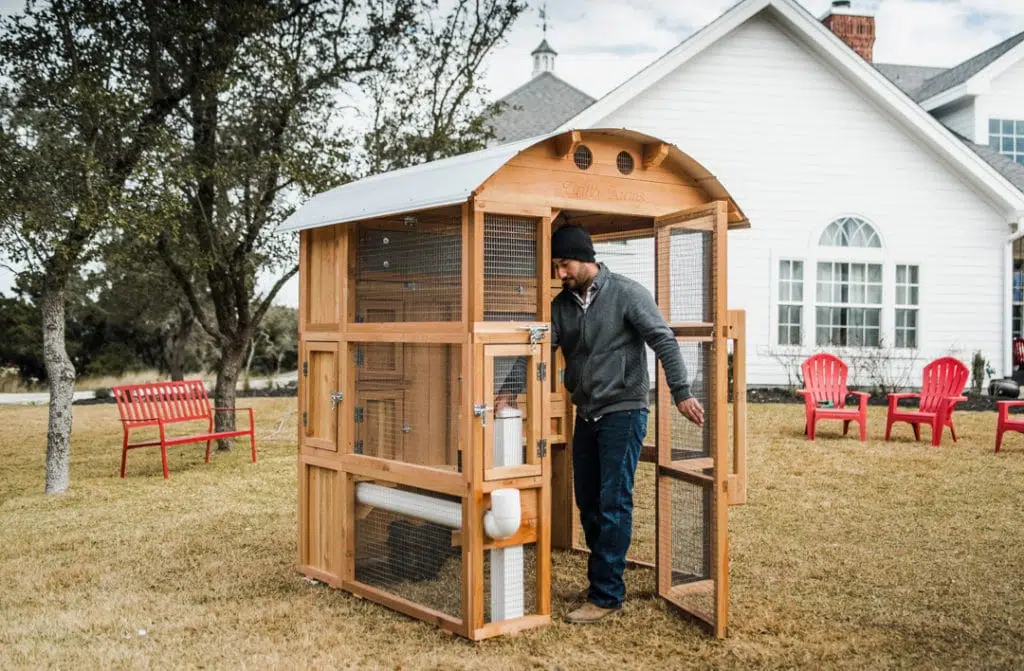
Roost&Root Round-Top Stand-Up Chicken Coop

A happy wife, mother, teacher, writer, hobby farmer, lover of chickens, and contributor to Pampered Chicken Mama!



